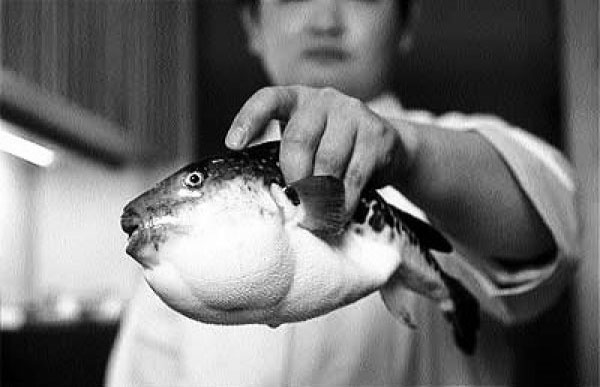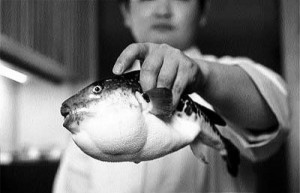Japanese cuisine includes some unique and amazing delicacies. One of the most interesting and dangerous dishes in Japanese cooking is Fugu, also known as Blowfish or Puffer Fish. Fugu is extremely poisonous if it is not prepared properly, and can be fatal if ingested. At the present time, only a very select number of chefs are authorized to serve and prepare Fugu. Surprisingly, the government in Tokyo is currently preparing to relax restrictions that permit only licensed and trained chefs to serve Fugu.
One Japanese chef who is licensed to prepare and serve Fugu is Kunio Miura, known as Miura-san. Miura-san displays a Fugu chef’s license above his work station, and has over 60 years of experience preparing Fugu, but still practices a high degree of care when serving this dish, as one mistake could be fatal for diners who eat the dish. Fugu is traditionally a winter dish. It is interesting that a dish that is potentially deadly would be associated with the month of the year when plants begin the cycle of death and rebirth.
Miura-san began his career at the age of 15, apprenticing in a kitchen. He trained for over two years, and at the age of 20 (the age that a Japanese citizen is considered a legal adult) he was able to obtain a license. It should be noted that about a third of those who take the exam to prepare Fugu fail it.
Miura-san’s Fugu preparation ritual is the same every time. He uses special knives in its preparation, which are designed by a sword smith and have extremely sharp edges. When not in use, these knives are stored separately in a designated box. He first lays the fish out on its stomach, and cuts the head open in order to remove and discard the eyes and brain. Those portions are placed into a tray designated for “non-edible” portions of the fish.
Miura-san next removes all of the skin, and begins to slice at the innards of the fish. He cautions that the ovaries are the most dangerous part, but that the intestines and liver of the blowfish can also be lethal. He states that “People say [Fugu] is 200 times more deadly than cyanide.” He reveals that only a small sliver of Fugu ovary would kill a person. After he is finished removing the poisonous portions of the fish, he is careful to lock them into a metal container, after which they will be conveyed to the main Tokyo fish market to be burned. This is the process for all such Fugu ovaries, intestines, and livers.
Governmental statistics indicate that since 2000 at least 23 people in Japan have died after eating Fugu. Most of these deaths are of individuals who attempt to prepare Fugu for themselves. Few, if any such deaths resulted from individuals eating Fugu that was prepared by a licensed chef in a restaurant. One woman required hospitalization after eating a small portion of Fugu liver at a Tokyo restaurant, but it was not the one Miura-san works for.
The dangerous chemical in Fugu is called Tetrodotoxin. Its symptoms begin with a numb sensation in the mouth area, swiftly followed by paralysis, and the death. At this time, there is no workable antidote. Worst of all, the victim is conscious until death.
Fugu chefs are the rock stars of Japan’s culinary world, and their skills are highly respected. They are truly considered elite. Japanese Fugu chefs are quite upset about the proposed change to licensing requirements. One of the new developments includes a plan to let restaurants purchase and serve Fugu that was prepared elsewhere.
Miura-san echoes the sentiment of dismay, stating that the exam is difficult, and that current licensed Fugu chefs put in considerable effort to pass the exam. He is uncomfortable with new rules that would permit individuals to take a one day class, and then be allowed to sell Fugu. Currently, a chef needs to cut over 100 fish in order to gain the skill, which costs a large amount of money.
If the proposed changes come to pass in Tokyo, Tokyo would resemble many other cities that have allowed restaurants to sell Fugu that is pre-prepared for quite some time. Fugu is regularly sold via the internet, and is also available in some supermarkets, which are two of the reasons behind the proposed changes.
The changes would also make Fugu available at more (and cheaper) restaurants, and Izakayas (pubs). As many diners enjoy the thrill of trying this poisonous fish, it is likely that Fugu sales would skyrocket if it became more readily available at less expensive prices.
Some diners report that they felt a tingling sensation when eating Fugu that they believed to be due to traces of Tetrodotoxin remaining in the fish. However, Muira-san does not think this is the case. He also debunks the popular myth that if a diner should die from eating Fugu, the chef would commit ritual suicide. Instead, he says that chef would face litigation, a fine, a loss of license, or prison time.
Fugu stew is one popular dish that Miura-san prepares. He also makes grilled Fugu with Teriyaki sauce. Today, he is preparing Fugu-sashimi, which involves slicing the fish very thinly, and arranging it like a flower on a serving dish. The slices are so thin that the pattern on the dish is visible through the exotic and rare cuisine.
Fugu does not have a powerful taste, but does taste a bit like chicken. It is usually dipped in soy sauce. It is also a bit chewy. Before dipping it in the soy sauce, it is traditionally poached in broth which sits on a burner on top of the table. This dish is called Shabu-Shabu.
Japanese foodies will tell you that the taste of Fugu is definitely distinctive, and that its texture is extremely unique. Food texture is very important to Japanese food lovers, and as a result there are many different words in the Japanese language to describe food texture.


